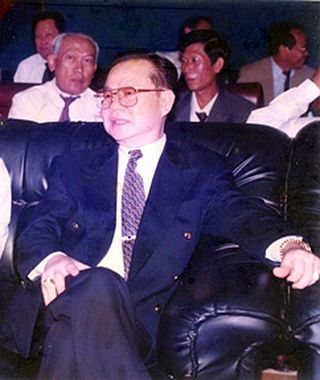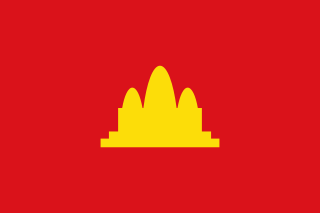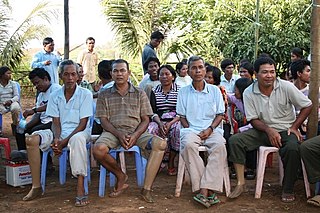
Phnom Penh is the capital and most populous city of Cambodia. It has been the national capital since the French protectorate of Cambodia and has grown to become the nation's primate city and its economic, industrial, and cultural centre. Before Phnom Penh became capital city, Oudong was the capital of the country.
Articles related to Cambodia and Cambodian culture include:

Cambodia is divided into 25 provinces. The capital Phnom Penh is not a province but an "autonomous municipality", equivalent to a province governmentally and administered at the same level as the other 24 provinces.

Pailin is a province in western Cambodia at the northern edge of the Cardamom Mountains near the border of Thailand. This province is surrounded by Battambang province, and was officially carved out of Battambang to become a separate administrative division after the surrender of the Ieng Sary faction of the Khmer Rouge in 1996. Pailin is known to much of the world for having long been a stronghold of the Khmer Rouge, remaining under their control long after they were defeated in 1979 and serving from 1994 to 1998 as the capital of the Provisional Government of National Union and National Salvation of Cambodia. Within Cambodia, Pailin is known for its natural resources, namely precious gems and timber.

Nuon Chea, also known as Long Bunruot or Rungloet Laodi, was a Cambodian communist politician and revolutionary who was the chief ideologist of the Khmer Rouge. He also briefly served as acting Prime Minister of Democratic Kampuchea. He was commonly known as "Brother Number Two", as he was second-in-command to Khmer Rouge leader Pol Pot, General Secretary of the Party, during the Cambodian genocide of 1975–1979. In 2014, Nuon Chea received a life sentence for crimes against humanity, alongside another top-tier Khmer Rouge leader, Khieu Samphan, and a further trial convicted him of genocide in 2018. These life sentences were merged into a single life sentence by the Trial Chamber on 16 November 2018. He died while serving his sentence in 2019.

The Dhammayietra is an annual peace walk in Cambodia that originated during the historic repatriation of refugees along the Thai border camps during the United Nations monitored transition to democracy in 1992. The Khmer word "dhammayietra", derived from the Pāli dhamma and yātrā, means "pilgrimage" but is often translated as "pilgrimage of truth". The peace walk takes place in early May and usually involves an assemblage of Buddhist monks and laity who travel various routes in Cambodia.

The largest of the ethnic groups in Cambodia are the Khmer, who comprise 95.8% of the total population and primarily inhabit the lowland Mekong subregion and the central plains. The Khmer historically have lived near the lower Mekong River in a contiguous arc that runs from the southern Khorat Plateau where modern-day Thailand, Laos and Cambodia meet in the northeast, stretching southwest through the lands surrounding Tonle Sap lake to the Cardamom Mountains, then continues back southeast to the mouth of the Mekong River in southeastern Vietnam.

Teng Bunma 許銳騰, also written as Teng Boonma, Theng Boonma, and Theng Bunma, was one of the wealthiest businessmen in Cambodia. He was one the founders of Thai Boon Roong Group and, along with Sok Kong and Meng Retthy, he was well known as one of the “four tigers” of the Cambodian economy after the fall of the Khmer Rouge, between the 1980s-2000s.

Democratic Kampuchea was the official name of the Cambodian state from 1976 to 1979, under the totalitarian dictatorship of Pol Pot and the Communist Party of Kampuchea (CPK), commonly known as the Khmer Rouge. The Khmer Rouge's capture of the capital Phnom Penh in 1975 effectively ended the United States-backed Khmer Republic of Lon Nol.

Operation Eagle Pull was the United States military evacuation by air of Phnom Penh, Cambodia, on 12 April 1975. At the beginning of April 1975, Phnom Penh, one of the last remaining strongholds of the Khmer Republic, was surrounded by the Khmer Rouge and totally dependent on aerial resupply through Pochentong Airport. With a Khmer Rouge victory imminent, the US government made contingency plans for the evacuation of US nationals and allied Cambodians by helicopter to ships in the Gulf of Thailand. Operation Eagle Pull took place on the morning of 12 April 1975 and was a tactical success carried out without any loss of life. Five days later the Khmer Republic collapsed and the Khmer Rouge occupied Phnom Penh.

Mongkol Borey is a district (srok) in the south of Banteay Meanchey Province, in northwestern Cambodia. The district capital is the town of Mongkol Borey, around nine kilometres south of the provincial capital of Serei Saophoan by road. The district shares a border with Battambang Province to the south. The main railway line from Phnom Penh to Poipet on the border with Thailand runs through the district from north to south.

The National Army of Democratic Kampuchea (NADK) was a Cambodian guerrilla force. NADK were the armed forces of the Party of Democratic Kampuchea also known as "Khmer Rouge", operating between 1979 and the late 1990s.
Sala Krau is a district located in Pailin Province, western Cambodia. The district is subdivided into 4 communes and 43 villages. According to the 1998 census of Cambodia, it had a population of 7,106.

The Kula people are the descendants of migrants from Burma who settled in the Pailin-Chanthaburi region along the Cambodia–Thailand border during the 19th century. To which Burmese ethnic group the Kulas belong remains uncertain, with some speculating a Bamar, Shan or multi-ethnic heritage.
The Democratic National Union Movement (DNUM) was a Cambodian political party founded after senior Khmer Rouge official Ieng Sary's defection from the Cambodian National Unity Party in August 1996. A magazine entitled Phka Rik is associated with it. It was created primarily to facilitate Ieng Sary's reentry into civilian political life, claiming neutrality and that he had broken away from the Khmer Rouge and from the "fascism and cruelty of Pol Pot's regime," naming Nuon Chea, Ta Mok, Son Sen and Yun Yat as Pol Pot's cohorts and "mass murderers of Cambodia." He stated that he was a supporter of "limited democracy"; he named Thailand, Singapore, and Japan as examples.

The Communist Party of Kampuchea (CPK), also known as the Khmer Communist Party, was a communist party in Cambodia. Its leader was Pol Pot, and its members were generally known as the Khmer Rouge. Originally founded in 1951, the party was split into pro-Chinese and pro-Soviet factions as a result of the Sino–Soviet split with the former being the Pol Pot faction, and the latter adopting a more revisionist approach to Marxism. As such, it claimed that 30 September 1960 was its founding date; it was named the Workers' Party of Kampuchea before it was renamed the Communist Party in 1966.

The Fall of Phnom Penh was the capture of Phnom Penh, capital of the Khmer Republic, by the Khmer Rouge on 17 April 1975, effectively ending the Cambodian Civil War. At the beginning of April 1975, Phnom Penh, one of the last remaining strongholds of the Khmer Republic, was surrounded by the Khmer Rouge and totally dependent on aerial resupply through Pochentong Airport.
The following lists events that happened during 1975 in Cambodia.

Khmer nationalism is a form of nationalism found in Cambodia, that asserts that Khmers (Cambodians) are a nation and promotes the cultural unity of the Khmer (Cambodian) race.

The battle of Pailin also known as the Siege of Pailin is an armed conflict which extended from 1989 to 1997 as the last military act of the Khmer Rouge insurgency which took place in the Northwest of Cambodia in the last military stronghold of the Khmer Rouge.




















